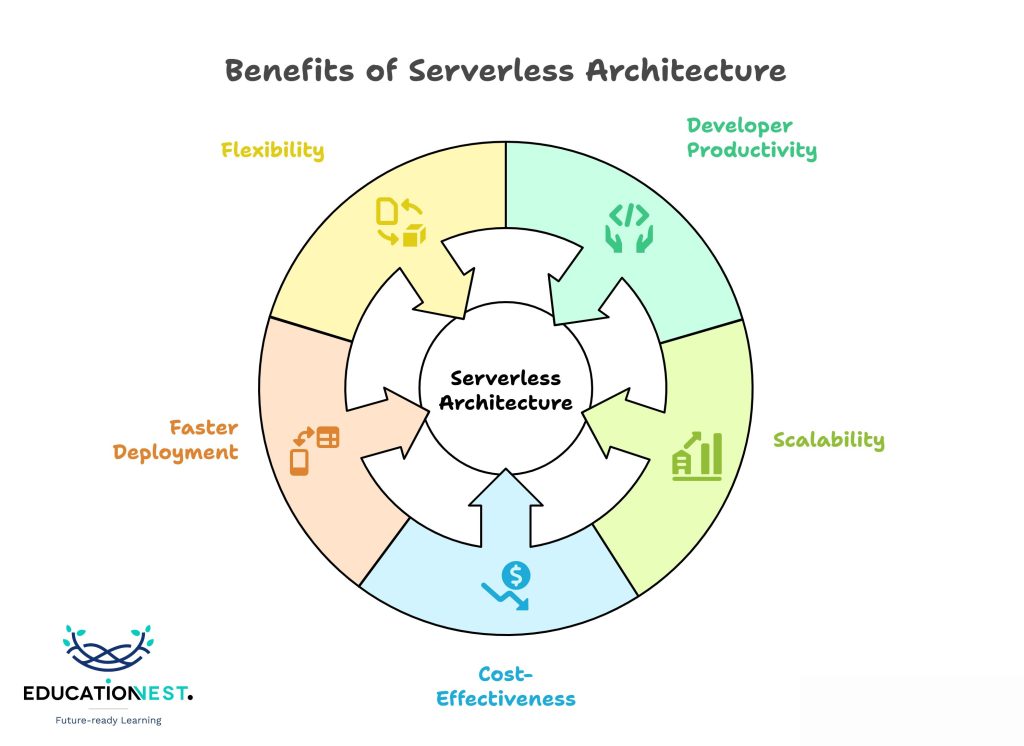Serverless computing is changing the way developers build and deploy applications. It eliminates the need for managing back-end infrastructure. Developers can therefore focus solely on writing and running code. With this model, cloud providers handle everything. This is why some experts refer to it as Function as a Service (FaaS) — because developers write functions that execute only when triggered by specific events.
The adoption of serverless computing is growing rapidly. In this article, we break down what is serverless computing or architecture. We also touch upon its benefits and why it is a game-changer for developers. Whether you are building web applications, APIs, or microservices, understanding serverless architecture can be a huge game-changer for you.
What is Serverless Computing?
Serverless computing is a cloud execution model where developers can build and run applications without managing servers. They simply write code. The cloud provider handles everything else. That is from server management and scaling to maintenance. This means businesses can deploy applications faster and at a lower cost.
Despite the name, serverless computing does not mean there are no servers. It just removes the need for developers to manage them. Developers don’t have to worry about provisioning or maintaining them. The cloud provider runs the infrastructure behind the scenes. They automatically handle deployment, scaling, and maintenance. Businesses only pay for the exact computing power used. Thus, it is a cost-efficient alternative.
Serverless vs. Other Cloud Computing Models
You might wonder — doesn’t cloud computing already offer on-demand resources? Yes, cloud service models like Infrastructure as a Service (IaaS) and Platform as a Service (PaaS) are there. They do provide computing power on a pay-as-you-go basis. However, they still require active resource management.
With IaaS and PaaS, the infrastructure stays running even when it is not in use. You pay for idle resources. You are also responsible for scaling servers or configuring applications to adjust to demand.
Serverless computing works differently. It is completely event-driven. This means resources are only allocated when needed. The cloud provider automatically scales up or down based on real-time demand. This means you never pay for idle time. Your applications can also instantly handle fluctuations in traffic without manual intervention. This is the biggest advantage of serverless computing. It is a much more efficient and cost-effective alternative to traditional cloud models.
Benefits of Serverless Architecture
A 2019 survey found 40% of companies were already using some form of serverless architecture. Cost savings was one of the biggest advantages for them. They were paying only for the exact computing power used. The infrastructure costs were significantly low by maintaining high scalability and reliability. Come, let’s take a look at the various benefits of serverless architecture:
1. Higher developer productivity
Serverless computing lets developers focus on writing code and optimizing business logic. They don’t have to worry about managing servers. They don’t have to worry about provisioning, scaling, or maintaining infrastructure. This speeds up development and allows teams to deliver faster.
2. Automatic and instant scalability
Serverless architectures scale up or down automatically based on demand. Traditional cloud autoscaling requires configuring rules and thresholds. Instead, serverless scales instantly. It can even scale down to zero when not in use – optimizing resource usage.
3. Cost-effective pricing
Another benefit of serverless computing is cost-effectiveness. With this kind of model, you only pay for what you use. Costs are based on the actual execution time of functions rather than a fixed infrastructure fee. Since there is no payment for idle resources, businesses can significantly reduce operational costs. Such costs usually run high when they run their own servers.
4. Faster deployment
Serverless removes the need for DevOps teams to spend time setting up infrastructure. Crucial time is saved for integration, testing, and deployment. Developers can simply write and push code into production, speeding up release cycles and improving agility.
5. Language and framework flexibility
Serverless platforms support multiple programming languages. This is another pro of serverless computing. It allows teams to develop in the language they prefer. Python, Java, Go, Node.js, .NET, and more – it supports a lot of languages. This flexibility is huge for businesses that need to build applications faster without being locked into a specific tech stack.
If you are looking to reap these advantages, training your team is a must. Offline/online corporate training programs from EducationNest have helped multiple corporate companies in their training efforts.

Serverless Computing: Examples and Use Cases
Serverless computing is excellent for event-driven. It is best used for in-demand tasks that require quick execution without continuous resource usage. Serverless computing is changing how apps handle backend tasks. It removes the need to manage servers, allowing functions to run only when needed. Serverless computing offers two main types of services: Function as a Service (FaaS) and Backend as a Service (BaaS).
1. Function as a Service (FaaS)
FaaS provides computing resources to run application logic in response to specific events. Each function performs a single task, running in fully managed cloud environments without requiring infrastructure setup. These functions scale automatically and only consume resources when executed. Hence, serverless computing offers FaaS which is cost-efficient and highly flexible.
2. Backend as a Service (BaaS)
BaaS offers complete backend functionality for web and mobile applications. This includes authentication, database management, cloud storage, push notifications, and hosting. BaaS developers don’t need to manage servers, containers, or virtual machines. They can focus on building features rather than handling infrastructure.
Here are some practical applications of serverless computing:
- Third-party API integration – Seamlessly connect and interact with external services. These could be payment gateways or even authentication providers.
- Scheduling tasks – Automating daily reports, backups, compliance checks, and security scans without managing dedicated servers.
- IT process automation – Automating workflows like removing user access, initiating compliance security checks, or approving requests.
- Real-time data processing – Handling structured and unstructured data streams efficiently. You can enable instant analytics and decision-making.
- Continuous integration and delivery (CI/CD) pipelines – Automate code deployment, monitoring, and testing in DevOps workflows.
- REST API backends – Build and manage scalable API endpoints without provisioning servers.
- Trigger-based actions – Execute functions based on events such as database updates, user actions, or file uploads.
- Asynchronous processing – Run background tasks without blocking the main application. This improves speed and efficiency both.
- Real-time notifications – Send instant alerts, updates, or reminders based on system events or user interactions.
Read More
What Are the Cloud Service Models: Types and Examples
Efficient Cloud Architectures Using Best Practices for AWS Solutions Architects
Best Cloud Computing Certifications For IT Professionals
Conclusion
We hope this blog covers all your questions regarding serverless computing like what it is, its benefits, and its use cases. Companies should choose a serverless platform that supports end-to-end application development. It should include services for databases, storage, messaging, data analytics, and ML. At the same time, it should also ensure smooth integration and scalability. While serverless offers cost savings and automatic scaling, it also comes with challenges. Limited runtimes and vendor lock-in can make switching providers difficult. It can also reduce flexibility. Developers often struggle between the speed of serverless computing and the control of containers.
If you are looking for corporate training courses in Noida to train your in-house teams in this domain, look no further than EducationNest. With expert-led, customizable courses on data analytics, cybersecurity, ML, and much more, they have already garnered the title of best corporate training provider in Delhi.
